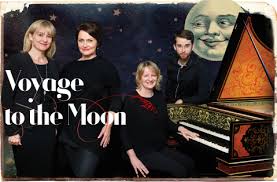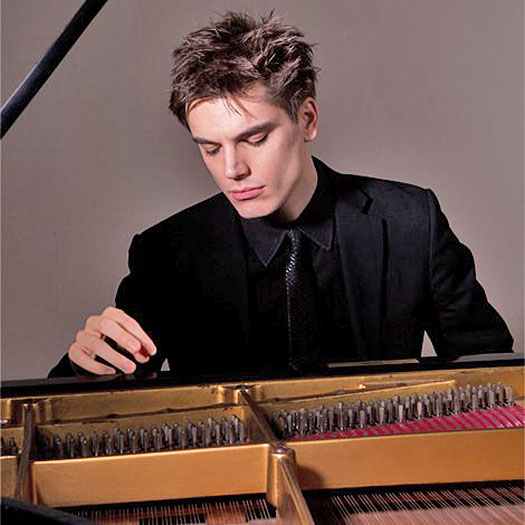On A Voyage To The Moon With Michael Gow

I admit I was piqued that Melbourninans had the first squizz at Voyage to the Moon when it opened there last week. Here in Sydney, our turn arrives tonight when the production opens at the City Recital Hall.
A venture between Musica Viva and Victorian Opera, Voyage to the Moon is a Baroque pastiche – a collection of unrelated music by various composers of the Baroque era, built on a new or existing libretto, creating a single new composite work. Australian playwright and director Michael Gow has written a new libretto for this production which he has directed with the score constructed by the late international Baroque expert Alan Curtis.
Michael Gow’s libretto is inspired by Ariosto’s poem Orlando Furioso, an epic tale that has fuelled many operas. Speaking to SoundsLikeSydney Michael Gow explains why:
“The poem is full of amazing characters and situations and has a fantastical element to it. You can almost draw a direct line between the poem and stories like Harry Potter. There is a fascination with the supernatural and mythology and because Baroque opera was so extraordinarily over the top they looked to these extravagant stories with larger than life characters. So I turned to it as the source for this project.”
The small but stellar cast performing this semi-staged, costumed theatre piece, comprises singers with gold clad credentials in Baroque performance – soprano Emma Matthews, mezzo-soprano Sally-Anne Russell and emerging artist bass-baritone Jeremy Kleeman. Phoebe Briggs, Head of Music at Victorian Opera at the harpsichord, leads an ensemble of expert chamber musicians.
In the tale, Orlando, sung by Emma Matthews, goes mad when he learns that his beloved loves another and goes off “rampaging around the world. His friend Astolfo, sung by Sally-Anne Russell, learns that everything that has been lost on earth is stored on the moon. With the help of a Magus (Kleeman), Astolfo goes to the moon and through his loyalty persuades a fierce Lunar to let him take Orlando’s sanity, allowing Astolfo to return to earth and cure his friend.
Gow continues, “Most of the score was assembled in collaboration with Alan Curtis, a towering figure in the modern rediscovery of the music of this era. Sadly Alan passed away before we finished it, but most of it was done.”
The pastiche form which appeared in the late 17th century, is not without its detractors who claim that it lacks originality, noting that even the term derives from un pasticcio – the Italian word for ‘pastry’. However, through the 18th century, the merits of the pastiche came to be recognised, with composers like Vivaldi, Bononcini, Handel, Hasse, Gluck, Mozart and Haydn contributing to the genre.
In defence of the pastiche, Gow says ” It was common practice and it wasn’t entirely theft. It was also a way of paying homage to other composers’ brilliance by saying ‘This is a great tune – I’m going to put it in my show because it’s wonderful and audiences should hear it.’ There are so many thousands of these operas which never see the light of day and no one ever does them but invariably there are one or two pieces in all of them that are absolutely brilliant and it’s a way of bringing these items to the public ” adding reverentially, “I made the decision not to use any music from any of the Orlando operas – I thought that was cheating a bit.”
Almost a year ago, SoundsLikeSydney interviewed William Christie prior to his tour to Australia with Les Arts Florisants and Les Jardin des Voix. Christie conducted the premiere of the operatic pastiche The Enchanted Isle at the Metropolitan Opera in New York in 2011. A milestone in Baroque music, it is essentially a ‘mash-up’ of forgotten Baroque works, some over 300 years old. Christie described the project as “great fun,” adding “The most important thing is that it’s a way of getting this music into these halls like the Met.” The pastiche is not entirely new to Sydney Baroque fans. In July last year, Pinchgut Opera presented Bajazet, an operatic pastiche of music by various composers, but mostly by Vivaldi.
Alan Curtis was an American conductor, Baroque scholar and harpsichordist. He studied with Gustav Leonhardt, gained his PhD with a dissertation on Sweelinck’s keyboard works and rose to become a professor at the University of California at Berkeley. Keyboard music and opera were his passions and he also practised his craft as harpsichordist and conductor in the USA and Europe, specialising in the historically informed performance of the music of the 16th, 17th and 18th centuries.
Curtis’ score for Voyage to the Moon, includes works by Handel and Vivaldi, but also by a coterie of composers from states and principalities around Baroque Europe – de Majo, Gluck, Orlandini and Hasse, whose arias Gow describes as “absolute show stoppers.” Hasse’s flair may well have been grounded in his personal understanding of the voice as he was married to the legendary mezzo-soprano Faustina Bordoni. Gow adds “Because we’ve got this great band made up of some of the best soloists in the country and to give the singers a rest, we included some purely orchestral moments – there is an instrumental piece from Ariodante by Handel and one from Alcina. As well, we play as travelling music, a movement from one of Telemann’s oboe concertos. Emma Black who’s our oboist plays this movement which is wonderful to hear.”
Inevitably some music had to be written de novo, for which Curtis wrote a recitative and aria. Says Gow “He composed it with a great sense of the style of the period with the recitative leading into a period aria. Traditionally, a recitative can go on for pages and pages. Alan’s concern was that in a compact piece like this, it not be too long. So it’s in the correct style but it’s not as long as you’d expect if you went to one of these original operas.”
Tragically Curtis died suddenly during the project – too suddenly to even plan for his absence. “His death was completely unexpected. He was 81, but fit as a fiddle and he was suddenly gone. It was a complete shock. He brought to the project a mind was like a vast archive of music. He knew that part of music history inside out. He could pluck things out of the air and know exactly where to find the mouldy old manuscripts we’d decided to use – and he was a great musician, very big in the revival of early music, a great conductor and coach of singers. He had a whole range of amazing skills.”
The collaboration between Gow and Curtis, involved many emails and daily Skype sessions between the Melbourne based cast and creative team and the Florence based Curtis. “During Skyped workshops in Melbourne some young artists from Victorian Opera would sing some of the libretto while I was writing,” says Gow, “and Alan was able to hear how it sounded. Some big decisions were made that way.”
There is another layer to the project. Led by Professor Jane Davidson, the Australian Research Council Centre of Excellence for The History of Emotions has been tracking the emotional journeys of the cast and creatives as they bring Voyage to the Moon to life. “It’s the sort of thing a creative person would normally shy away from but I am interested in seeing the results. Anything that helps the process is valuable as long as it doesn’t short-circuit the artists and create doubts wondering whether you’re doing the ‘right’ thing in terms of the data. It’s like reading books on how to write – you don’t really want to read them but they are fascinating to read because they do give you a slightly different way of thinking.”
The research has tracked the process from the time that Gow started to write the libretto through the collaboration and rehearsal to performance. “There’s been someone in the room pretty much all the time making notes. They would also interview various people, mainly me, but everyone has been asked about what it’s like and where we want it to go, are we getting there and do we feel the problems and the issues. They’re looking at what we’ve been aiming for, the choices we make and what we’re trying to arouse in the audience – what their experience might be. I’ve never done this before.”
Gow is oblivious to just how well Melbourne has received Voyage to the Moon. “I have no idea what the critics think. For me, the audiences are having a great time. They’re really responding to all the aspects – they understand the serious elements and some of the philosophical moments but they also love the thrill of the singers performing this amazing music. That’s always the reward for me.”
Shamistha de Soysa for SoundsLikeSydney©
Voyage to the Moon opens at the City Recital Hall, Sydney tonight, February 22 at 7 pm, with a matinee on Saturday 27 at 2 pm.
Click here for performances in other capital cities and bookings.





